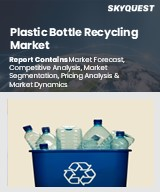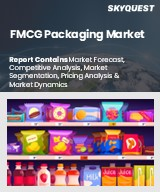
|
시장보고서
상품코드
1617132
세계의 폴리에틸렌 테레프탈레이트 시장 : 제품, 형태, 용도, 최종 사용자, 지역별 세계 분석 예측(-2030년)Polyethylene Terephthalate Market Forecasts to 2030 - Global Analysis by Product (Virgin PET and Recycled PET), Form (PET Resin and PET Film), Application, End User and By Geography |
||||||
Stratistics MRC에 따르면 폴리에틸렌 테레프탈레이트 시장은 2024년 317억 7,000만 달러를 차지하고 예측 기간 동안 복합 연간 성장률(CAGR) 5.4%로 성장하여 2030년에는 435억 6,000만 달러에 이를 것으로 예상됩니다. 합성 폴리머?강도, 내구성, 내약품성, 내습성이 뛰어나므로, 섬유 제품, 포장 재료, 병 등의 용기의 제조에 자주 이용되고 있습니다. 따라서 환경 친화적 인 패키지 옵션으로 인기가 있습니다.
International Bottled Water Associations 2018의 보고서에 따르면 미국 병 음료수 시장 소비는 128억 800만 갤런에서 1,371억 500만 갤런으로 증가했습니다.
증가하는 패키지 수요
특히 식품 및 식품 업계의 포장 요구가 증가함에 따라 폴리에틸렌 테레프탈레이트(PET) 시장을 뒷받침하고 있습니다. 부드럽게 지속 가능한 제품에 대한 소비자의 선호도 증가도 PET의 보급을 추진하고 있습니다. PET는 효과적이고 보호성이 높은 포장 재료 중 하나이며, 전자상거래와 온라인 쇼핑의 확대에 따라, 그 필요성은 점점 높아지고 있습니다. 잠재력을 우선시함에 따라 이 동향은 가속될 것으로 예상됩니다.
원재료 가격 변동
특히 테레프탈산과 에틸렌글리콜의 원재료 가격의 변동은 제조비용을 인상함으로써 폴리에틸렌 테레프탈레이트(PET) 시장에 과제를 가져오고 있습니다.의 안정성과 제조업의 수익성에 영향을 미칠 수 있습니다. 또한 공급망 관리가 어려워 장기 투자를 방해하고 시장 확대를 방해합니다.
재활용 진전
폴리에틸렌 테레프탈레이트(PET)의 재활용 기술은 급속히 발전하고 있으며 시장 성장을 뒷받침하고 있습니다. 등의 기술 혁신에 의해 가능하게 되었습니다. 능성 목표를 달성하고 생산 비용을 절감하며 처녀 자원의 필요성을 줄이는 데 도움이 됩니다. 순환 경제를 지원하고 재활용 PET를 시장에서 중요한 상품으로 확립하고 있습니다.
재활용 과제
폴리에틸렌 테레프탈레이트(PET) 사업의 재활용 문제는 처리 비용 증가와 재활용률의 감소로 인해 지속가능성에 대한 노력을 저해하고 있습니다. PET 리 사이클을 방해하고 있으며, 그 결과 재활용 PET가 적어 버진 원료 수요가 높아져 환경 목표에 영향을 미치고 있습니다. 되었습니다.
COVID-19의 영향:
COVID-19의 대유행은 폴리에틸렌 테레프탈레이트(PET) 시장을 혼란시켜 수요 및 공급의 변동을 일으켰습니다. 업계의 포장 수요에 영향을 미쳤습니다. 그러나 전자상거래 및 건강 관리 관련 패키징 증가는 부분적으로 손실을 상쇄했습니다. 솔루션의 향후 성장을 가속합니다.
예측 기간 동안 처녀 PET 부문이 최대가 될 전망
버진 PET 분야는 우수한 품질, 순도 및 일관성으로 인해 고성능 용도에 이상적이기 때문에 예측 기간 동안 최대가 될 것으로 예상됩니다. 포장, 자동차, 섬유 제품에 일반적으로 사용 산업계가 프리미엄 제품과 소비재를 위한 고품질 소재를 우선하는 가운데, 버진 PET 수요는 특히 식품 안전성과 지속 가능한 패키징 솔루션을 필요로 하는 분야에서 계속 성장하고 있어 시장에서의 존재감을 한층 더 높이고 있습니다.
자동차 분야가 예측 기간 중 가장 높은 복합 연간 성장률(CAGR)이 예상된다.
자동차 분야는 PET의 높은 강도, 내약품성, 재활용성에 의해 코팅, 보닛 부품, 내장 부품 등의 자동차 용도에 최적이기 때문에 예측 기간 중에 가장 높은 복합 연간 성장률(CAGR)이 예상됩니다. 잠재력과 연비 효율을 높이기 위해 차량의 경량화에 주력하고 있기 때문에 자동차 제조에 있어서의 PET의 사용은 점점 늘어나고 있으며, 이것이 자동차 산업에 있어서의 PET 소재 수요 증가를 뒷받침하고 있습니다.
최대 점유율을 차지하는 지역
북미는 특히 식음료를 중심으로 한 포장 업계 수요 증가에 따라 예측 기간 중 최대 시장 점유율을 차지할 것으로 예상됩니다. 게다가 지속 가능한 소재에 대해 의식 증가와 PET 재활용 기술의 혁신은 시장 성장을 더욱 강화하고 있습니다.
복합 연간 성장률(CAGR)이 가장 높은 지역:
아시아태평양은 도시화와 산업화 속도가 빠르며 특히 식품 및 식품 산업에서 포장 재료에 대한 요구가 높아지기 때문에 예측 기간 동안 가장 높은 복합 연간 성장률(CAGR)을 나타낼 것으로 예상됩니다. 전자상거래의 성장과 환경 친화적 인 포장 옵션에 대한 소비자의 욕구가 커짐에 따라 더욱 강화되고 있습니다.
무료 맞춤 서비스
이 보고서를 구독하는 고객은 다음 무료 맞춤설정 옵션 중 하나를 사용할 수 있습니다.
- 기업 프로파일
- 추가 시장 기업의 종합적 프로파일링(3개사까지)
- 주요 기업의 SWOT 분석(3개사까지)
- 지역 세분화
- 고객의 관심에 응한 주요국 시장 추계 및 예측, 복합 연간 성장률(CAGR)(주: 타당성 확인에 따름)
- 경쟁 벤치마킹
- 제품 포트폴리오, 지리적 존재, 전략적 제휴에 기반한 주요 기업 벤치마킹
목차
제1장 주요 요약
제2장 서문
- 개요
- 이해관계자
- 조사 범위
- 조사 방법
- 데이터 마이닝
- 데이터 분석
- 데이터 검증
- 조사 접근
- 조사 정보원
- 1차 조사 정보원
- 2차 조사 정보원
- 전제조건
제3장 시장 동향 분석
- 성장 촉진요인
- 억제요인
- 기회
- 위협
- 제품분석
- 용도 분석
- 최종 사용자 분석
- 신흥 시장
- COVID-19의 영향
제4장 Porter's Five Forces 분석
- 공급기업의 협상력
- 구매자의 협상력
- 대체품의 위협
- 신규 진입업자의 위협
- 경쟁 기업간 경쟁 관계
제5장 세계의 폴리에틸렌 테레프탈레이트 시장 : 제품별
- 버진 PET
- 재활용 PET
제6장 세계의 폴리에틸렌 테레프탈레이트 시장 : 형태별
- PET 수지
- PET 필름
제7장 세계의 폴리에틸렌 테레프탈레이트 시장 : 용도별
- 패키지
- 섬유
- 자동차
- 일렉트로닉스
- 기타 용도
제8장 세계의 폴리에틸렌 테레프탈레이트 시장 : 최종 사용자별
- 식품 및 음료
- 소비재
- 기타 최종 사용자
제9장 세계의 폴리에틸렌 테레프탈레이트 시장 : 지역별
- 북미
- 미국
- 캐나다
- 멕시코
- 유럽
- 독일
- 영국
- 이탈리아
- 프랑스
- 스페인
- 기타 유럽
- 아시아태평양
- 일본
- 중국
- 인도
- 호주
- 뉴질랜드
- 한국
- 기타 아시아태평양
- 남미
- 아르헨티나
- 브라질
- 칠레
- 기타 남미
- 중동 및 아프리카
- 사우디아라비아
- 아랍에미리트(UAE)
- 카타르
- 남아프리카
- 기타 중동 및 아프리카
제10장 주요 발전
- 계약/파트너십/협업/합작투자(JV)
- 인수와 합병
- 신제품 발매
- 사업 확대
- 기타 주요 전략
제11장 기업 프로파일링
- Indorama Ventures
- Eslon Chemical Co. Ltd.
- SABIC
- Reliance Industries
- Lotte Chemical
- Teijin Limited
- IHS Markit
- Far Eastern New Century Corporation
- PetroChina
- Kraton Polymers
- China National Petroleum Corporation
- Shenzhen Longhui New Materials Co. Ltd
- Mitsubishi Chemical Corporation
- Kaiser Group
- JBF Industries
- Nan Ya Plastics Corporation
- BASF
- Alpek
According to Stratistics MRC, the Global Polyethylene Terephthalate Market is accounted for $31.77 billion in 2024 and is expected to reach $43.56 billion by 2030 growing at a CAGR of 5.4% during the forecast period. Polyethylene Terephthalate (PET) is a flexible synthetic polymer from the polyester family that is produced by polymerizing terephthalic acid (TPA) and ethylene glycol (EG). Because of its strength, durability, and resistance to chemicals and moisture, it is commonly utilized in the production of fibers for textiles, packaging materials, and containers like bottles. PET is a popular option for environmentally friendly packaging because of its exceptional recyclability, clarity, and low weight.
According to the International Bottled Water Associations 2018 report, bottled water market consumption in the US increased from 12,808 million gallons to 13,7105 million gallons.
Market Dynamics:
Driver:
Growing Demand for Packaging
Growing need for packaging, particularly in the food and beverage industries, is propelling the polyethylene terephthalate (PET) market. PET is a great material for packaging because it is lightweight, strong, and recyclable. PET uptake is also being aided by growing consumer preference for eco-friendly and sustainable products. PET is one of the effective and protective packaging materials that are becoming more and more necessary as e-commerce and online shopping grow. As packaging increasingly prioritizes sustainability, this trend is anticipated to pick up speed.
Restraint:
Fluctuating Raw Material Prices
Fluctuating raw material prices, notably for terephthalic acid and ethylene glycol, present challenges to the polyethylene terephthalate (PET) market by raising production costs. PET product prices may become erratic as a result of this price volatility, which could have an impact on market stability and manufacturing profitability. Additionally, it makes supply chain management more difficult, deters long-term investment, and impedes market expansion.
Opportunity:
Advancements in Recycling
Polyethylene Terephthalate (PET) recycling technologies are progressing at a rapid pace, propelling market growth. More effective PET recovery and reuse are made possible by innovations such as improved depolymerization procedures, improved sorting systems, and chemical recycling. These innovations assist achieve sustainability goals, cut production costs, and lessen the need for virgin resources. The use of these recycling processes is growing as consumer demand for environmentally friendly products rises, supporting a circular economy and establishing recycled PET as a vital commodity in the worldwide market.
Threat:
Recycling Challenges
Recycling problems in the polyethylene terephthalate (PET) business stifle sustainability efforts by raising processing costs and decreasing recycling rates. Inadequate infrastructure, complicated sorting, and contamination impede effective PET recycling. As a result, there is less recycled PET available, which raises demand for virgin materials and affects environmental objectives. Furthermore, market expansion is constrained by the high expenses of sophisticated recycling technology.
Covid-19 Impact:
The COVID-19 pandemic disrupted the Polyethylene Terephthalate (PET) market, causing fluctuations in demand and supply. Lockdowns and factory closures led to production slowdowns, while reduced consumer activity affected packaging demand, particularly in industries like beverages and food. However, the rise in e-commerce and healthcare-related packaging partially offset losses. As economies recovered, PET demand rebounded, with sustainability trends driving future growth in recycling and eco-friendly packaging solutions.
The virgin PET segment is expected to be the largest during the forecast period
The virgin PET segment is expected to be the largest during the forecast period due to its superior quality, purity, and consistency, which make it ideal for high-performance applications. Virgin PET is commonly used in packaging, automotive, and textiles, where strength, clarity, and durability are critical. As industries prioritize high-quality materials for premium products and consumer goods, the demand for virgin PET continues to grow, particularly in sectors requiring food-safe and sustainable packaging solutions, further expanding its market presence.
The automotive segment is expected to have the highest CAGR during the forecast period
The automotive segment is expected to have the highest CAGR during the forecast period because PET is perfect for automotive applications, including as coatings, under-the-hood parts, and interior components, due to its high strength, chemical resistance, and recyclability. PET is becoming more and more used in vehicle manufacturing as automakers concentrate on lowering vehicle weight for increased sustainability and fuel efficiency, which is helping to drive up demand for the material in the automotive industry.
Region with largest share:
North America is anticipated to hold the largest market share during the forecast period owing to increasing demand from the packaging industry, especially for food and beverage products. PET's durability, lightweight nature, and recyclability make it a preferred choice. Additionally, the rising awareness of sustainable materials and innovations in PET recycling technologies further boost market growth. Strong consumer preference for eco-friendly packaging, coupled with advancements in manufacturing processes, also supports the expansion of the PET market in the region.
Region with highest CAGR:
Asia Pacific is anticipated to witness the highest CAGR over the forecast period because of the quickening pace of urbanization and industrialization as well as the rising need for packaging materials, particularly in the food and beverage industries. PET consumption is further bolstered by the region's growing e-commerce and rising consumer desire for eco-friendly packaging options. The market's expansion is further aided by large expenditures in recycling technologies and the growing use of PET in the automotive and textile industries.
Key players in the market
Some of the key players in Polyethylene Terephthalate market include Indorama Ventures, Eslon Chemical Co., Ltd., SABIC, Reliance Industries, Lotte Chemical, Teijin Limited, IHS Markit, Far Eastern New Century Corporation, PetroChina, Kraton Polymers, China National Petroleum Corporation, Shenzhen Longhui New Materials Co., Ltd, Mitsubishi Chemical Corporation, Kaiser Group, JBF Industries, Nan Ya Plastics Corporation, BASF and Alpek.
Key Developments:
In July 2024, Neste and Mitsubishi Corporation have agreed to establish a strategic partnership focused on developing value chains for renewable chemicals and plastics for and with Japanese brands. The partners are targeting brands in industries such as food and beverage, apparel, and consumer electronics.
In July 2024, DigiLens Inc announced a deepening partnership with Mitsubishi Chemical Corporation global leader in the chemical industry - to bring to market the first-ever plastic waveguides for XR glasses at a performance, cost, and scale for consumer and enterprise use.
In January 2024, Mitsubishi UFJ Financial Group and PsiQuantum announced that they are beginning work with Mitsubishi Chemical Group on a joint project to simulate excited states of photochromic molecules which have widespread industrial and residential potential applications such as the development of smart windows, energy-efficient data storage, solar energy storage and solar cells, and other photoswitching use cases.
Products Covered:
- Virgin PET
- Recycled PET
Forms Covered:
- PET Resin
- PET Film
Applications Covered:
- Packaging
- Textiles
- Automotive
- Electronics
- Other Applications
End Users Covered:
- Food & Beverage
- Consumer Goods
- Other End Users
Regions Covered:
- North America
- US
- Canada
- Mexico
- Europe
- Germany
- UK
- Italy
- France
- Spain
- Rest of Europe
- Asia Pacific
- Japan
- China
- India
- Australia
- New Zealand
- South Korea
- Rest of Asia Pacific
- South America
- Argentina
- Brazil
- Chile
- Rest of South America
- Middle East & Africa
- Saudi Arabia
- UAE
- Qatar
- South Africa
- Rest of Middle East & Africa
What our report offers:
- Market share assessments for the regional and country-level segments
- Strategic recommendations for the new entrants
- Covers Market data for the years 2022, 2023, 2024, 2026, and 2030
- Market Trends (Drivers, Constraints, Opportunities, Threats, Challenges, Investment Opportunities, and recommendations)
- Strategic recommendations in key business segments based on the market estimations
- Competitive landscaping mapping the key common trends
- Company profiling with detailed strategies, financials, and recent developments
- Supply chain trends mapping the latest technological advancements
Free Customization Offerings:
All the customers of this report will be entitled to receive one of the following free customization options:
- Company Profiling
- Comprehensive profiling of additional market players (up to 3)
- SWOT Analysis of key players (up to 3)
- Regional Segmentation
- Market estimations, Forecasts and CAGR of any prominent country as per the client's interest (Note: Depends on feasibility check)
- Competitive Benchmarking
- Benchmarking of key players based on product portfolio, geographical presence, and strategic alliances
Table of Contents
1 Executive Summary
2 Preface
- 2.1 Abstract
- 2.2 Stake Holders
- 2.3 Research Scope
- 2.4 Research Methodology
- 2.4.1 Data Mining
- 2.4.2 Data Analysis
- 2.4.3 Data Validation
- 2.4.4 Research Approach
- 2.5 Research Sources
- 2.5.1 Primary Research Sources
- 2.5.2 Secondary Research Sources
- 2.5.3 Assumptions
3 Market Trend Analysis
- 3.1 Introduction
- 3.2 Drivers
- 3.3 Restraints
- 3.4 Opportunities
- 3.5 Threats
- 3.6 Product Analysis
- 3.7 Application Analysis
- 3.8 End User Analysis
- 3.9 Emerging Markets
- 3.10 Impact of Covid-19
4 Porters Five Force Analysis
- 4.1 Bargaining power of suppliers
- 4.2 Bargaining power of buyers
- 4.3 Threat of substitutes
- 4.4 Threat of new entrants
- 4.5 Competitive rivalry
5 Global Polyethylene Terephthalate Market, By Product
- 5.1 Introduction
- 5.2 Virgin PET
- 5.3 Recycled PET
6 Global Polyethylene Terephthalate Market, By Form
- 6.1 Introduction
- 6.2 PET Resin
- 6.3 PET Film
7 Global Polyethylene Terephthalate Market, By Application
- 7.1 Introduction
- 7.2 Packaging
- 7.3 Textiles
- 7.4 Automotive
- 7.5 Electronics
- 7.6 Other Applications
8 Global Polyethylene Terephthalate Market, By End User
- 8.1 Introduction
- 8.2 Food & Beverage
- 8.3 Consumer Goods
- 8.4 Other End Users
9 Global Polyethylene Terephthalate Market, By Geography
- 9.1 Introduction
- 9.2 North America
- 9.2.1 US
- 9.2.2 Canada
- 9.2.3 Mexico
- 9.3 Europe
- 9.3.1 Germany
- 9.3.2 UK
- 9.3.3 Italy
- 9.3.4 France
- 9.3.5 Spain
- 9.3.6 Rest of Europe
- 9.4 Asia Pacific
- 9.4.1 Japan
- 9.4.2 China
- 9.4.3 India
- 9.4.4 Australia
- 9.4.5 New Zealand
- 9.4.6 South Korea
- 9.4.7 Rest of Asia Pacific
- 9.5 South America
- 9.5.1 Argentina
- 9.5.2 Brazil
- 9.5.3 Chile
- 9.5.4 Rest of South America
- 9.6 Middle East & Africa
- 9.6.1 Saudi Arabia
- 9.6.2 UAE
- 9.6.3 Qatar
- 9.6.4 South Africa
- 9.6.5 Rest of Middle East & Africa
10 Key Developments
- 10.1 Agreements, Partnerships, Collaborations and Joint Ventures
- 10.2 Acquisitions & Mergers
- 10.3 New Product Launch
- 10.4 Expansions
- 10.5 Other Key Strategies
11 Company Profiling
- 11.1 Indorama Ventures
- 11.2 Eslon Chemical Co., Ltd.
- 11.3 SABIC
- 11.4 Reliance Industries
- 11.5 Lotte Chemical
- 11.6 Teijin Limited
- 11.7 IHS Markit
- 11.8 Far Eastern New Century Corporation
- 11.9 PetroChina
- 11.10 Kraton Polymers
- 11.11 China National Petroleum Corporation
- 11.12 Shenzhen Longhui New Materials Co., Ltd
- 11.13 Mitsubishi Chemical Corporation
- 11.14 Kaiser Group
- 11.15 JBF Industries
- 11.16 Nan Ya Plastics Corporation
- 11.17 BASF
- 11.18 Alpek



















